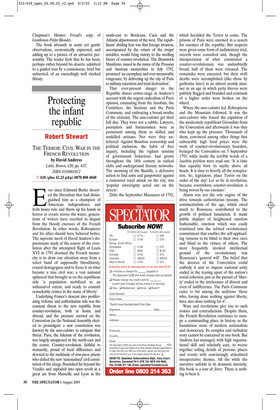Protecting the infant republic
Robert Stewart
THE TERROR: CIVIL WAR IN THE FRENCH REVOLUTION by David Andress Little, Brown, £20, pp. 437, ISBN 0316861812 V £18 (plus £2.25 p&p) 0870 800 4848 Ever since Edmund Burke deserted the liberalism that had distinguished him as a champion of American independence and Irish home rule and threw up his hands in horror at events across the water, generations of writers have recoiled in disgust from the bloody excesses of the French Revolution. In other words, Robespierre and his allies should have behaved better. The supreme merit of David Andress’s dispassionate study of the course of the revolution after the attempted flight of Louis XVI in 1791 doomed the French monarchy is to draw our attention away from a select band of supposedly bloodthirsty, crazed demagogues and to focus it on what became a true civil war, a vast national upheaval that brought in on the republican side ‘a population mobilised to an unheard-of extent, and ready to commit remarkable crimes in the name of liberty’.
Underlying France’s descent into proliferating violence and authoritarian rule was the constant threat to the new republic from counter-revolution, both at home and abroad, and the pressure exerted on the Convention (as the National Assembly elected to promulgate a new constitution was known) by the sans-culottes to extirpate that threat. Paris, the fulcrum of the revolution, was largely unopposed in the north-east and the centre. Counter-revolution, faithful to monarchy, proud of local differences and devoted to the multitude of non-juror priests who defied the new ‘nationalised’ civil constitution of the clergy, flourished far beyond the Vendée and exploded into open revolt in a great arc from Marseille and Lyon in the south-east to Bordeaux, Caen and the Atlantic départements of the west. The republicans’ abiding fear was that foreign invasion, accompanied by the return of the émigré notables, would bring victory to the swelling forces of counter-revolution. The Brunswick Manifesto, issued in the name of the Prussian and Austrian monarchies in July 1792, promised ‘an exemplary and ever-memorable vengeance, by delivering up the city of Paris to military execution and total destruction’.
That ever-present danger to the Republic shares centre-stage in Andress’s account with the urgent radicalism of Paris opinion, emanating from the Jacobins, the Cordeliers, the Sections and the Paris Commune, and embracing a broad swathe of the citizenry. The sans-culottes get their full due. They were not a rabble. Lawyers, journalists and businessmen were as prominent among them as skilled and unskilled artisans. Nor were they unlettered. Against Bourbon censorship and political exclusion, the habit of free inquiry, including the vigilant scrutiny of government behaviour, had grown throughout the 18th century in radical clubs and underground literary networks. The storming of the Bastille, a defensive action to find arms and gunpowder against a rumoured royal attack on the city, was ‘popular sovereignty acted out on the streets’.
Ditto the September Massacres of 1792, which heralded the Terror to come. The prisons of Paris were stormed in a search for enemies of the republic. But suspects were given some form of rudimentary trial, records were consulted and, though the interpretation of what constituted a counter-revolutionary was undoubtedly broad, half of them were released. The remainder were executed, but their swift deaths were accomplished (like those by guillotine later) in an almost seemly manner in an age in which petty thieves were publicly flogged and branded and criminals of a higher order were broken on the wheel.
Where the sans-culottes led, Robespierre and the Mountain followed. It was the sans-culottes who forced the expulsion of the moderately republican Girondists from the Convention and afterwards it was they who kept up the pressure. Thousands of them, convinced among other things that unbearably high food prices were the work of counter-revolutionary hoarders, besieged the Convention on 5 September 1793, while inside the terrible words of a Jacobin petition were read out: ‘It is time that equality bore its scythe above all heads. It is time to horrify all the conspirators. So, legislators, place Terror on the order of the day! Let us be in revolution, because everywhere counter-revolution is being woven by our enemies.’ Alarm was not the sole engine of the drive towards authoritarian tyranny. The sentimentalism of the age, which owed much to Rousseau, contributed to the growth of political fanaticism. It made public displays of heightened emotion fashionable; emotion which was easily translated into the refined revolutionary commitment that enables the self-applauding virtuous to be blind to their own vices and blind to the virtues of others. The most frequently invoked intellectual ground of the revolutionary was Rousseau’s ‘general will’. The belief that the decrees of the Convention could embody it and so impose national unity ended in the tearing apart of the nation’s social cohesion, just as the pursuit of ‘liberty’ ended in the intolerance of dissent and even of indifference. The Paris Commune came to list among the seditious ‘those who, having done nothing against liberty, have also done nothing for it’.
Wars and revolutions give rise to such ironies and contradictions. Despite them, the French Revolution continues to occupy a commanding place in history as the foundation stone of modern nationalism and democracy. Its complex and turbulent story cannot be contained in one book. But Andress has managed, with high organisational skill and scholarly care, to weave together telling details of persons, places and events with convincingly articulated interpretative themes. All the while the narrative unfolds in its dramatic intensity. His book is a tour de force. There is nothing to beat it.











































 Previous page
Previous page